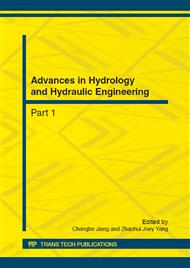p.744
p.748
p.752
p.759
p.765
p.772
p.780
p.789
p.796
Observed Changes of Drought/Wetness Episodes in the Middle and Lower Reaches of the Yangtze River, China
Abstract:
Monthly precipitation data of 76 meteorology stations over the middle and lower reaches of Yangtze river for 1961–2010 were analyzed by using the standardized precipitation index (SPI) and aridity index (I) for the rainy season (April–September) and winter (December– February). Trends of the number of wet and dry months were tested with Mann-Kendall technique. The results showed that: (1) The middle and lower reaches of the Yangtze River as a whole has become wetter during the rainy season and winter. (2) Major parts of the study area are characterized by increasing frequencies of severe and moderate wet months in the rainy season. (3) The study tries to explore the spatial and temporal changes in the wet and dry conditions across the middle and lower reaches of the Yangtze River by using SPI and I, and get the complete picture of the change of wet and dry.
Info:
Periodical:
Pages:
765-771
Citation:
Online since:
October 2012
Authors:
Price:
Сopyright:
© 2012 Trans Tech Publications Ltd. All Rights Reserved
Share:
Citation:


